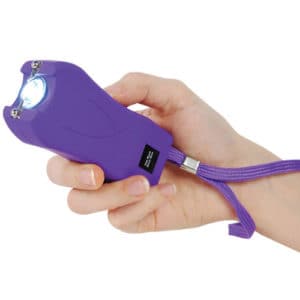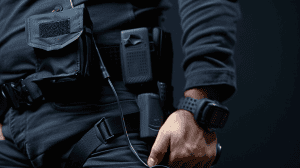Yes, stun guns are legal in Wisconsin, but you must comply with specific regulations. Individuals over 18 can possess them; a concealed carry permit is required if you plan to carry a stun gun. They’re strictly for self-defense, and you can’t use them in specific locations like school zones, public buildings, or bars. Minors are prohibited from owning them, and unlawful possession is a serious offense, punishable by up to six years in prison and fines reaching $10,000. Understanding the full scope of these laws guarantees you stay compliant and avoid severe penalties. To gain deeper insights, keep exploring the regulations.
Key Takeaways
- Stun guns are legal to possess in Wisconsin for individuals over 18.
- Carrying a stun gun requires a concealed carry permit.
- Stun guns are for self-defense only and are prohibited in school zones, public buildings, and bars.
- Unauthorized possession is a Class H felony, punishable by up to six years in prison and $10,000 in fines.
Wisconsin Stun Gun Laws
 While Wisconsin allows the possession of stun guns, there are specific laws you must follow to stay compliant. Understanding these regulations guarantees you don’t inadvertently break the law.
While Wisconsin allows the possession of stun guns, there are specific laws you must follow to stay compliant. Understanding these regulations guarantees you don’t inadvertently break the law.
The history of stun guns dates back to the 1960s when they were first developed as non-lethal self-defense tools. Their effectiveness in incapacitating attackers quickly made them popular among civilians and law enforcement.
You can legally own a stun gun in Wisconsin, but there are restrictions. For instance, minors aren’t allowed to possess stun guns, and carrying one in certain public buildings is prohibited. Additionally, you must have a concealed carry permit if you plan to hold a stun gun on your person.
The law also mandates that any stun gun be used only for self-defense. Misusing a stun gun, even in self-defense, can lead to legal consequences if it’s deemed excessive or unnecessary.
Definition of Stun Gun
A stun gun is an electrical self-defense device designed to temporarily incapacitate an assailant by delivering a high-voltage, low-amperage shock. You can use it to protect yourself by causing muscle contractions and pain, which disrupt the attacker’s ability to move. Understanding this definition is essential for knowing how and when to use a stun gun effectively for personal safety.
Electrical Self-Defense Device
Stun guns are electrical self-defense devices that deliver a high-voltage shock to incapacitate an attacker. These devices disrupt the body’s muscle functions and nervous system, making them highly effective in quickly stopping an assailant. The stun gun’s effectiveness is largely due to the electrical charge it emits, which ranges from 50,000 to several million volts. This high-voltage shock can temporarily paralyze muscles, giving you time to escape a dangerous situation.
When considering using a stun gun, it’s essential to understand electrical safety. While these devices are designed to be non-lethal, improper use can still pose risks. Always follow the manufacturer’s guidelines and verify the stun gun is maintained correctly. Additionally, remember that a stun gun’s effectiveness can vary based on clothing thickness and the assailant’s size.
Understanding the legal definitions and restrictions surrounding stun guns is critical for lawful possession and use in Wisconsin. As electrical self-defense devices, they offer a potent means of protection, but only when used correctly and within legal bounds. Educate yourself thoroughly to maximize safety and effectiveness.
Temporary Incapacitation Tool
 Understanding how stun guns function as a temporary incapacitation tool is key to using them effectively for self-defense. A stun gun delivers a high-voltage but low-amperage electrical charge, which disrupts the body’s neuromuscular system, causing temporary muscle spasms and disorientation. This incapacitation usually lasts a few minutes, giving you a vital window to escape and seek help.
Understanding how stun guns function as a temporary incapacitation tool is key to using them effectively for self-defense. A stun gun delivers a high-voltage but low-amperage electrical charge, which disrupts the body’s neuromuscular system, causing temporary muscle spasms and disorientation. This incapacitation usually lasts a few minutes, giving you a vital window to escape and seek help.
As a temporary safety measure, stun guns allow you to defend yourself without causing permanent injury to the attacker. They’re designed to be non-lethal alternatives to firearms, making them an appealing choice for those concerned about using deadly force. Research shows that stun guns can effectively deter assailants, with success rates often exceeding 90%.
Using a stun gun requires minimal training, but you should understand its operational range, typically between direct contact and a few feet. For maximum effect, always aim for large muscle groups, such as the thigh or torso.
Knowing your local laws and regulations regarding stun gun possession and use is also essential. In Wisconsin, specific legal guidelines must be followed to guarantee responsible ownership and usage.
Who Can Possess a Stun Gun
In Wisconsin, only individuals over 18 can legally possess a stun gun. This legal age requirement guarantees that stun gun ownership is restricted to adults who are deemed capable of making responsible decisions regarding their use. If you’re considering owning a stun gun, it’s vital to understand the state’s regulations to avoid legal issues.
To gain a clearer picture, here’s a quick breakdown of the key points related to stun gun possession in Wisconsin:
| Criteria | Details | Importance |
|---|---|---|
| Legal Age | Must be over 18 | Guarantees maturity and responsibility |
| Legal Ownership | Allowed with certain restrictions | Compliance with state laws |
| Usage Restrictions | Specific locations and situations | Public safety and legal adherence |
You should be aware that while you can legally own a stun gun, there are specific restrictions on where and how you can carry and use it. These include prohibitions in certain public places and requirements for concealed carry permits, depending on the situation. Understanding these rules is essential to guarantee your compliance with Wisconsin law.
Age Restrictions
Given that Wisconsin law mandates that gun owners must be over 18, understanding the age restrictions is key to guaranteeing legal compliance. You must know that age verification is vital when purchasing or possessing a stun gun. Retailers are required to confirm that buyers meet the legal age requirement, often by requesting a valid ID at the time of purchase. This step is essential to prevent youth access to these devices.
In Wisconsin, it’s illegal for individuals under 18 to possess a stun gun. This law aims to reduce the risks of minors handling such potentially dangerous items. If you’re a parent or guardian, it’s your responsibility to guarantee that any stun gun in your home is inaccessible to minors. Using secure storage solutions, like locked cabinets, can help achieve this.
Failure to properly verify customers’ ages can result in significant legal consequences for retailers, including fines and potential loss of business licenses. As a result, both sellers and buyers must adhere strictly to these age restrictions.
Where Stun Guns Are Prohibited
 It’s crucial to know where you’re not allowed to carry or use stun guns in Wisconsin. Understanding these prohibited areas helps you avoid legal ramifications.
It’s crucial to know where you’re not allowed to carry or use stun guns in Wisconsin. Understanding these prohibited areas helps you avoid legal ramifications.
You can’t bring a stun gun into any school zone, including Wisconsin’s primary, secondary, and higher education institutions. Violating this rule can lead to severe penalties, including fines and possible imprisonment.
Public buildings are another category where stun guns are off-limits. This includes government offices, courthouses, and police stations. Carrying a stun gun in these places can result in immediate confiscation and legal consequences.
Additionally, you should avoid bringing stun guns into establishments that serve alcohol. Bars and nightclubs often have strict policies, and you could face fines or even a ban from the premises.
Some private properties also prohibit stun guns. Always check the rules of private businesses or homes before carrying a stun gun onto their property. Ignoring these restrictions can lead to trespassing charges or other legal issues.
Stun Gun Use in Self-Defense
When using a stun gun for self-defense in Wisconsin, you need to understand the legal scenarios where it’s permitted, ensuring you’re protecting yourself within the law. Familiarize yourself with personal safety guidelines to use the device effectively and responsibly. Additionally, be aware of specific restrictions limiting where and how to carry and use a stun gun.
Legal Self-Defense Scenarios
 In Wisconsin, you can legally use a stun gun in self-defense if you reasonably believe you’re in imminent danger. However, understanding when and how to use it is vital to avoid legal complications. Proper self-defense techniques guarantee you’re prepared and can effectively protect yourself while minimizing the risk of legal repercussions.
In Wisconsin, you can legally use a stun gun in self-defense if you reasonably believe you’re in imminent danger. However, understanding when and how to use it is vital to avoid legal complications. Proper self-defense techniques guarantee you’re prepared and can effectively protect yourself while minimizing the risk of legal repercussions.
When using a stun gun for self-defense, keep in mind these key points:
- Reasonable Belief: You must genuinely believe you’re at risk of immediate harm. The threat must be real and imminent.
- Proportional Force: The force you use should be proportional to the threat. Excessive force can lead to legal implications, including charges of assault.
- Retreat if Possible: If you can safely retreat or escape the situation, do so. Using a stun gun should be a last resort.
- Report the Incident: Report the incident to law enforcement after using a stun gun. Documenting the event can help protect you legally and provide a clear record of your actions.
Understanding these scenarios guarantees you use your stun gun responsibly and within the bounds of Wisconsin law, safeguarding your right to self-defense while avoiding unnecessary legal trouble.
Personal Safety Guidelines
Knowing how to use a stun gun effectively and safely is just as important as understanding the legal boundaries. Here are some self defense tips to enhance your personal safety when using a stun gun.
First, always aim for large muscle groups like the thighs or abdomen, as they are more likely to incapacitate an attacker. Second, practice regularly holding and activating your stun gun to guarantee your comfort and confidence in its use. Being familiar with your device is essential to respond quickly in an emergency.
| Self Defense Tip | Description |
|---|---|
| Aim for Large Muscles | Target thighs or abdomen for maximum effect. |
| Regular Practice | Familiarize yourself with the device to guarantee readiness. |
| Stay Aware | Always be mindful of your surroundings. |
Third, always stay aware of your surroundings. Being alert can help you recognize potential threats before they escalate. Keep your stun gun in an easily accessible location, such as a pocket or a holster. Quick access can be the difference between safety and danger.
Following these personal safety guidelines guarantees you use your stun gun effectively and responsibly, improving your overall security. Remember, the key to self-defense is preparation and awareness.
Stun Gun Restrictions
Before you carry a stun gun in Wisconsin, it’s important to understand the legal restrictions surrounding its use. While stun guns are generally legal in the state, there are specific guidelines you must follow to guarantee you’re compliant with the law.
First, the stun gun must be used strictly for self-defense purposes. Misuse can lead to serious legal consequences, so knowing the boundaries is vital.
Stun gun history and legal precedents in Wisconsin offer important insights into these restrictions. For example, several court rulings have clarified what constitutes appropriate use, emphasizing the necessity of immediate threat.
Here are four key points to keep in mind:
- Self-Defense Only: You can only use a stun gun to defend yourself or someone else from an immediate threat.
- Age Restrictions: You must be at least 18 to possess a stun gun legally.
- Prohibited Locations: Stun guns are banned in certain areas, such as schools and government buildings.
- Criminal Background: Individuals with certain criminal convictions are prohibited from owning a stun gun.
Purchasing Stun Guns in Wisconsin
When purchasing stun guns in Wisconsin, it’s important to understand the state’s specific regulations and requirements.
First, you’ll want to familiarize yourself with reputable stun gun dealers like Security Defense Weapons, known for their reliability and effectiveness. Choosing a well-regarded brand and company guarantees purchasing a product that meets safety and performance standards.
One of the top purchasing tips is to buy from authorized dealers or reputable online retailers. This reduces the risk of acquiring counterfeit or defective products. Additionally, checking customer reviews and ratings can provide insights into the product’s reliability and the seller’s credibility.
It’s also essential to understand the legalities surrounding stun guns in Wisconsin. You must be at least 18 years old to purchase a stun gun. While no permit is required, staying updated on any local ordinances that might impose further restrictions is wise. Always check the product specifications to confirm it complies with state laws, as certain features might be restricted.
Lastly, consider any training or instructional materials provided by the manufacturer. Proper usage is crucial for your safety and the stun gun’s effectiveness. Following these guidelines will help you make an informed and lawful purchase.
Stun Guns for Law Enforcement

When considering stun guns for law enforcement in Wisconsin, you’ll need to understand the authorized usage guidelines, training requirements, and safety protocols. Law enforcement officers must follow specific regulations to guarantee these devices are used effectively and safely. Proper training is essential to handle stun guns correctly, reducing the risk of injury to both officers and civilians.
Authorized Usage Guidelines
Law enforcement officers in Wisconsin must adhere to strict guidelines when using stun guns to assure public safety and uphold legal standards. Only authorized users, such as sworn police officers, are permitted to carry and deploy stun guns. These devices must be used to comply with state and departmental policies, focusing on minimizing harm while effectively controlling situations.
To guarantee proper use, officers must follow specific usage limitations:
- Situational Necessity: Stun guns should only be used when it’s necessary to subdue a suspect who poses an immediate threat to the officer or the public.
- Proportional Force: Stun guns must be proportional to the threat level, avoiding excessive force.
- Target Areas: Officers are trained to aim for specific body areas to reduce the risk of serious injury.
- Medical Attention: After deployment, officers must provide or arrange for immediate medical evaluation of the individual affected.
Training Requirements
 To guarantee officers use stun guns responsibly, they must undergo extensive training that covers both practical and theoretical aspects. This stun gun training is essential for confirming that law enforcement can effectively and safely handle these devices in various scenarios.
To guarantee officers use stun guns responsibly, they must undergo extensive training that covers both practical and theoretical aspects. This stun gun training is essential for confirming that law enforcement can effectively and safely handle these devices in various scenarios.
You’ll find that the training includes a detailed curriculum focusing on the mechanics of stun guns, appropriate usage situations, and potential risks involved.
In addition to the stun gun training, officers are often required to complete self-defense courses. These courses equip them with the skills necessary to manage confrontations without immediately resorting to stun guns. By understanding physical self-defense techniques, officers become more adept at evaluating each situation and determining the most appropriate response.
The training programs typically involve scenario-based exercises, which help officers practice their decision-making skills under stress. They also include legal education, confirming that officers are aware of the laws governing the use of stun guns in Wisconsin.
This blend of hands-on practice and theoretical knowledge confirms that officers can use stun guns effectively while minimizing harm to themselves and others.
This rigorous training confirms that law enforcement personnel are well-prepared to use stun guns responsibly, enhancing public safety and officer accountability.
Safety Protocols
After completing rigorous training, officers must adhere to strict safety protocols to guarantee the responsible use of stun guns in the field. These protocols are essential for promoting both officer and public safety. Proper safety training equips officers with the knowledge to handle stun guns effectively and minimize risks.
To maintain high standards of safety and emergency preparedness, officers should follow these key protocols:
- Regular Maintenance and Inspection: Verify stun guns are in peak condition by conducting regular checks and maintenance. This prevents malfunction during critical moments.
- Situational Awareness: Always assess the environment and potential threats before deploying a stun gun. This helps in making informed decisions that prioritize safety.
- Clear Communication: Before using a stun gun, communicate your intentions to fellow officers and bystanders. This reduces misunderstandings and enhances coordination during emergencies.
- Post-Deployment Procedures: After using a stun gun, follow specific procedures for documenting the incident and providing necessary medical attention to the individual affected.
Penalties for Illegal Possession
 Getting caught with a stun gun in Wisconsin without proper authorization can lead to serious legal consequences. If you’re found in illegal possession of a stun gun, the penalty consequences can be severe. Wisconsin law classifies unauthorized possession of a stun gun as a Class H felony. This means you could face up to six years in prison, a fine of up to $10,000, or both.
Getting caught with a stun gun in Wisconsin without proper authorization can lead to serious legal consequences. If you’re found in illegal possession of a stun gun, the penalty consequences can be severe. Wisconsin law classifies unauthorized possession of a stun gun as a Class H felony. This means you could face up to six years in prison, a fine of up to $10,000, or both.
In addition to incarceration and fines, having a felony on your record can have long-term effects on your life. It can impact your ability to secure employment, housing, and even specific professional licenses. Moreover, a felony conviction can limit your civil rights, including voting and possessing firearms.
It’s essential to understand that Wisconsin law requires specific authorization to carry a stun gun legally. This typically involves having a concealed carry permit. Without this permit, even if you believe you’re carrying the weapon for self-defense, you could still be subjected to the stringent penalties outlined by the law.
You must fully comply with all legal requirements to avoid these harsh consequences. Ignorance of the law isn’t a defense, so take the time to get properly informed and authorized.
Traveling With a Stun Gun
When traveling with a stun gun in Wisconsin, it’s important to understand the specific legal requirements and restrictions to avoid potential penalties. Stun gun regulations vary by locality, so knowing the rules is vital for travel safety and compliance. Here are four key points to keep in mind:
- Check Local Laws: Different Wisconsin municipalities may have stun gun regulations. Before traveling, research the laws in both your current location and destination.
- Concealed Carry Considerations: Wisconsin law permits concealed carrying of a stun gun, but if you plan to carry it, ensure you have a valid concealed carry license. Carrying without one can result in legal issues.
- Transportation Protocols: When transporting a stun gun, it’s advisable to keep it in a locked container, separate from ammunition, to guarantee its security and compliance with travel safety guidelines.
- Air Travel Restrictions: If flying, remember that stun guns are prohibited in carry-on luggage. Instead, they should be packed in checked baggage and declared by the airline at check-in to comply with TSA regulations.



